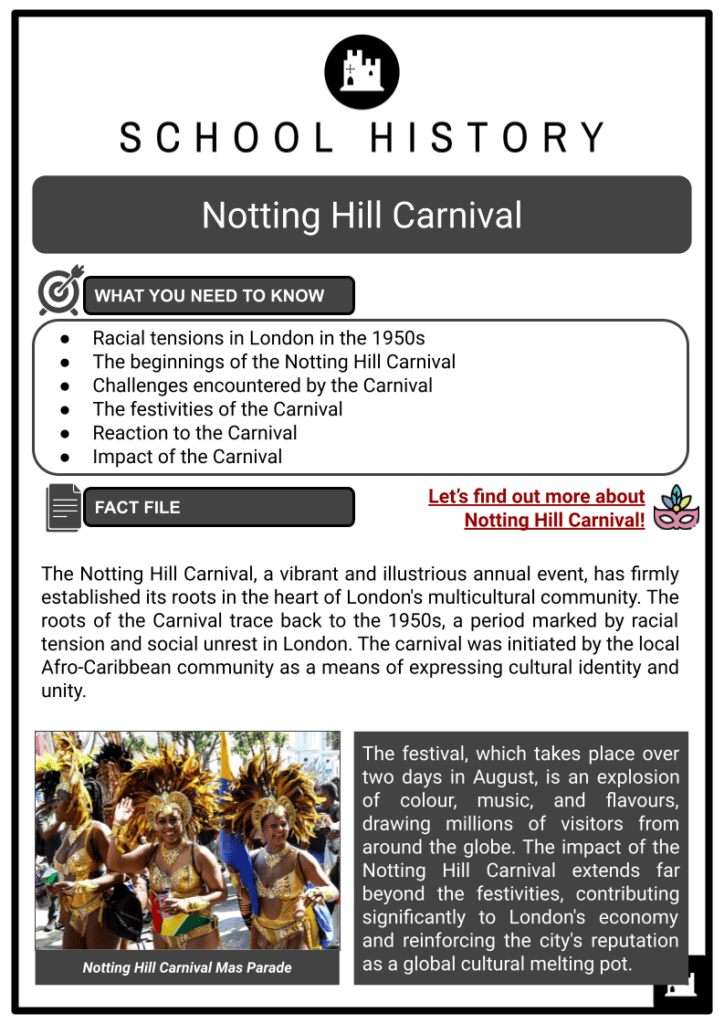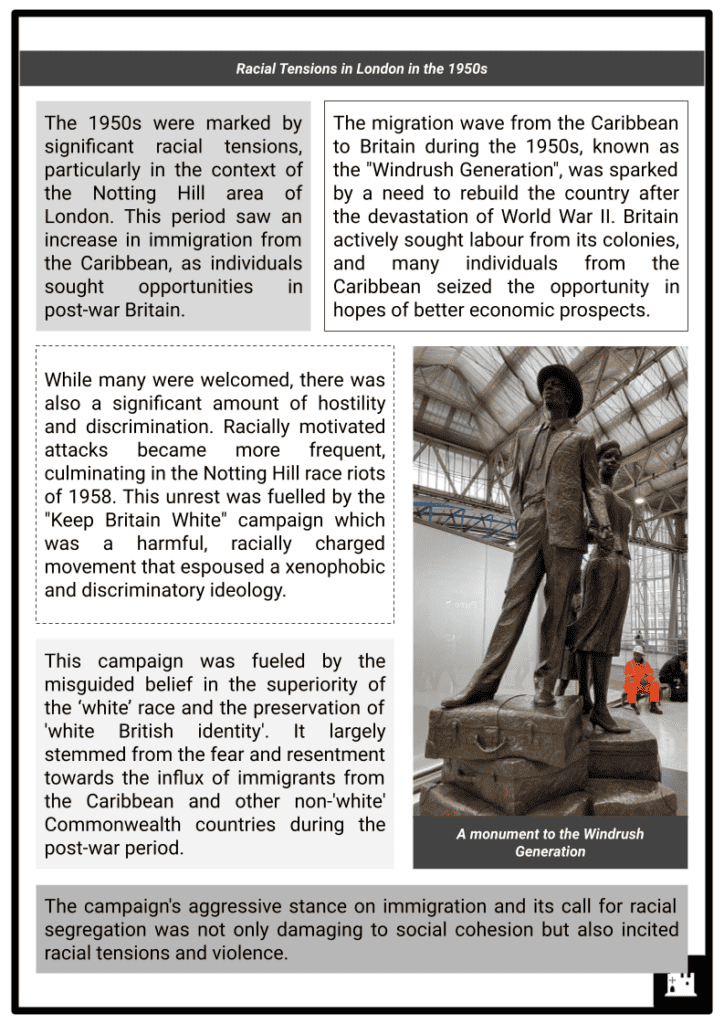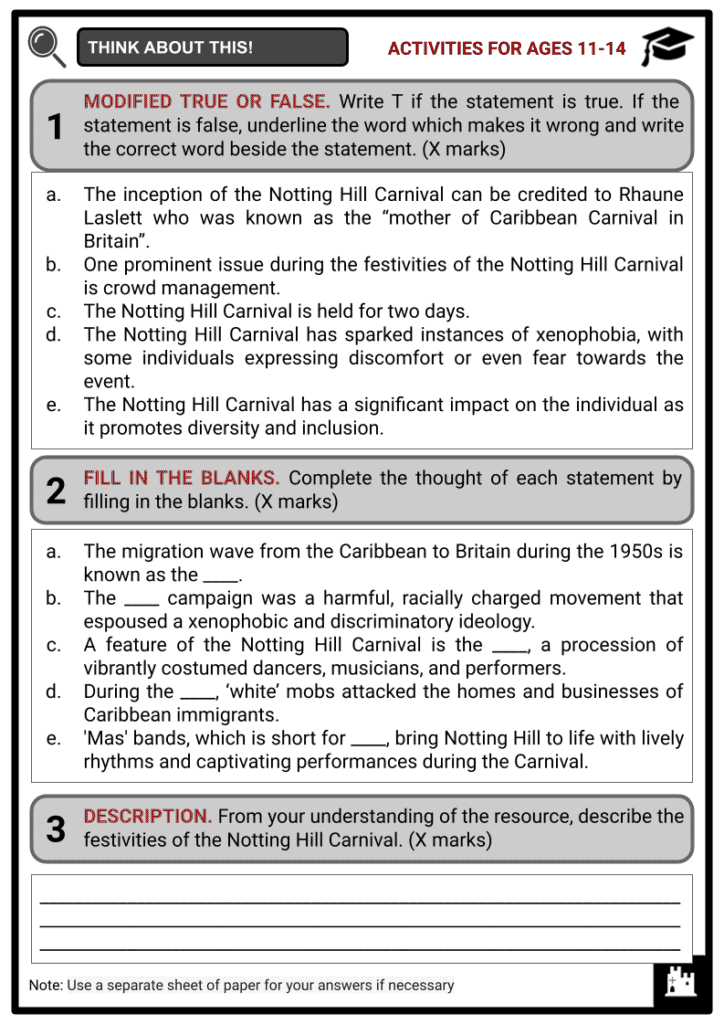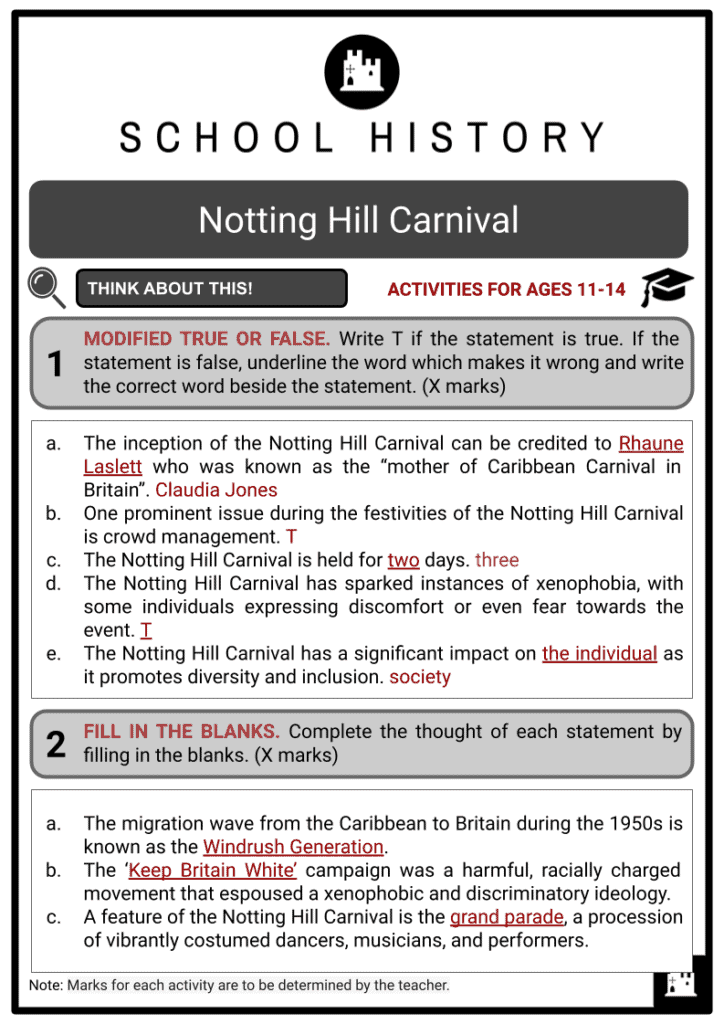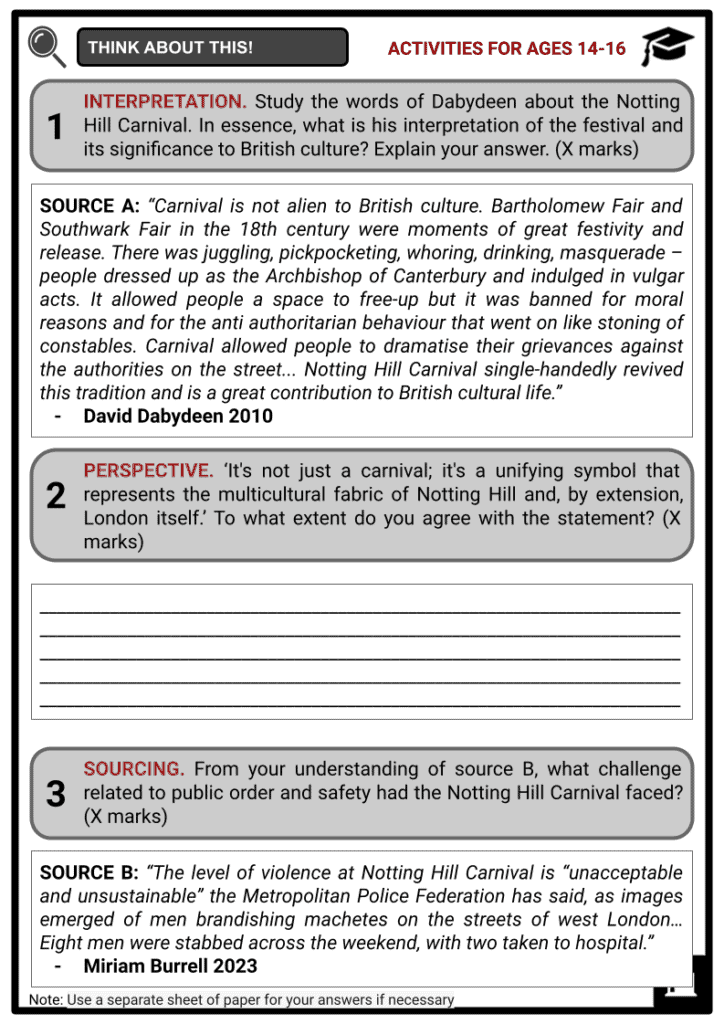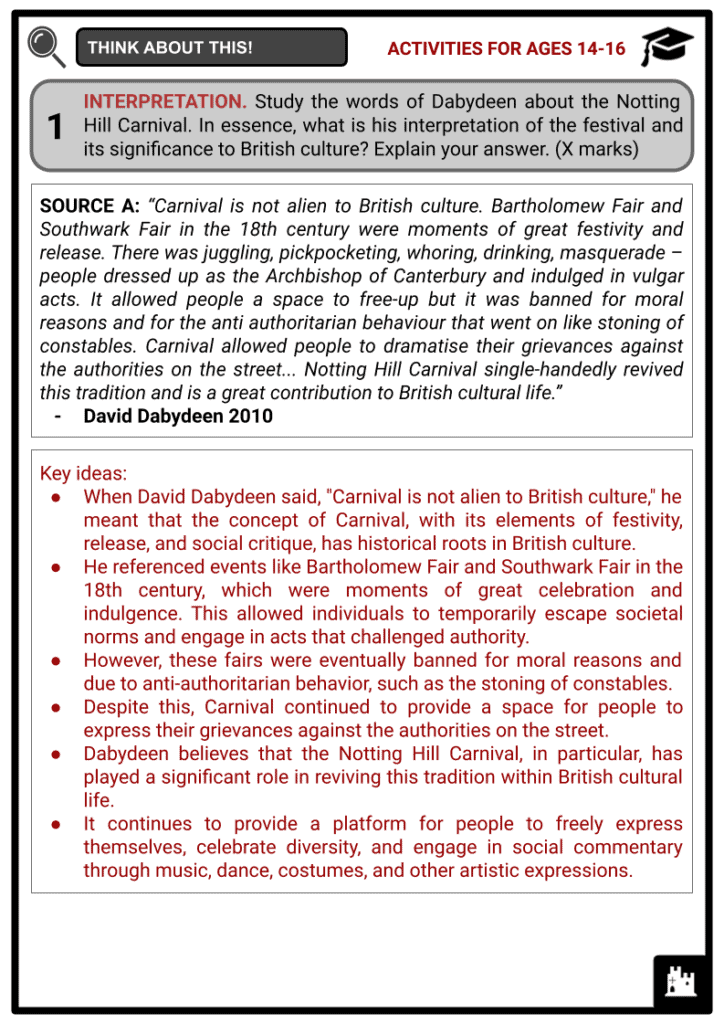Notting Hill Carnival Worksheets
Do you want to save dozens of hours in time? Get your evenings and weekends back? Be able to teach about Notting Hill Carnival to your students?
Our worksheet bundle includes a fact file and printable worksheets and student activities. Perfect for both the classroom and homeschooling!
Summary
- Racial tensions in London in the 1950s
- The beginnings of the Notting Hill Carnival
- Challenges encountered by the Carnival
- The festivities of the Carnival
- Reaction to the Carnival
- Impact of the Carnival
Key Facts And Information
Let’s find out more about Notting Hill Carnival!
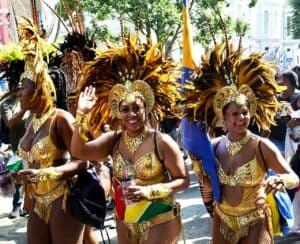
The Notting Hill Carnival, a vibrant and illustrious annual event, has firmly established its roots in the heart of London's multicultural community. The roots of the Carnival trace back to the 1950s, a period marked by racial tension and social unrest in London. The carnival was initiated by the local Afro-Caribbean community as a means of expressing cultural identity and unity. The festival, which takes place over two days in August, is an explosion of colour, music, and flavours, drawing millions of visitors from around the globe. The impact of the Notting Hill Carnival extends far beyond the festivities, contributing significantly to London's economy and reinforcing the city's reputation as a global cultural melting pot.
Racial Tensions in London in the 1950s
- The 1950s were marked by significant racial tensions, particularly in the context of the Notting Hill area of London. This period saw an increase in immigration from the Caribbean as individuals sought opportunities in post-war Britain.
- The migration wave from the Caribbean to Britain during the 1950s, known as the "Windrush Generation", was sparked by a need to rebuild the country after the devastation of World War II. Britain actively sought labour from its colonies, and many individuals from the Caribbean seized the opportunity in hopes of better economic prospects.
- While many were welcomed, there was also a significant amount of hostility and discrimination. Racially motivated attacks became more frequent, culminating in the Notting Hill race riots of 1958. This unrest was fuelled by the "Keep Britain White" campaign, which was a harmful, racially charged movement that espoused a xenophobic and discriminatory ideology.
- This campaign was fueled by the misguided belief in the superiority of the ‘white’ race and the preservation of 'white British identity'. It largely stemmed from the fear and resentment towards the influx of immigrants from the Caribbean and other non-'white' Commonwealth countries during the post-war period.
- The campaign's aggressive stance on immigration and its call for racial segregation was not only damaging to social cohesion but also incited racial tensions and violence.
- During the riots, 'white' mobs, driven by a fear of the unfamiliar and a desire to maintain racial segregation, attacked the homes and businesses of the Caribbean immigrants, triggering a week-long period of unrest. These deeply disturbing events exposed the extent of racial tensions and led to a profound backlash.
- The public outcry following these events prompted the British government to act, resulting in the first Race Relations Act of 1965. This legislation made it illegal to discriminate on the "grounds of colour, race, or ethnic or national origins" in public spaces. It marked the beginning of a legislative effort to address racial discrimination.
- Moreover, the aftermath of the riots led the local community to seek ways to repair the fragmented social ties and promote cultural understanding. This led to the birth of the Notting Hill Carnival in 1966, an event aimed at celebrating the cultural diversity and unity of the neighbourhood.
The Beginnings of the Carnival
- The Notting Hill Carnival was born out of a need for unity and celebration amidst a climate of racial tension and social unrest. Its inception can be credited to Claudia Jones, a Trinidad-born journalist and activist, often referred to as the “mother of Caribbean Carnival in Britain”. Jones organised an indoor Caribbean Carnival in 1959 as a response to the racial riots and hatred, intending to counteract the negative stereotypes about the Caribbean community that had been prevalent during this period.
- The event was a revelation, showcasing Caribbean culture through the mediums of music, dance, and cuisine, and it laid the foundational stone for the future Notting Hill Carnival.
- However, it wasn't until 1966 that the carnival took to the streets of Notting Hill, led by community activist Rhaune Laslett. Laslett envisioned a multicultural event that would bring together the diverse communities living in the Notting Hill area, and her vision resonated deeply within the community. Thus, the Notting Hill Carnival, as we know it today, was born.
- From its early beginnings, the Notting Hill Carnival was a showcase of the cultural wealth of the Caribbean community. The vibrant costumes, the energetic dancing, and the rhythmic music were all integral elements symbolising the Caribbean heritage.
Challenges Encountered
- The Notting Hill Carnival, despite its vibrant spectacle and unifying spirit, is not without its own set of challenges. One of the most prominent issues is crowd management. With over a million attendees each year, maintaining order and ensuring the safety of the masses is a daunting task requiring meticulous planning and robust security measures.
- Another challenge that often shadows the celebration is the issue of crime. Despite the majority of attendees being there for the joyous celebration, a small fraction sometimes engage in violent activities, casting a gloom over the otherwise festive event. These instances, although few, have sometimes led to a negative perception of the carnival, overshadowing the profound cultural exchange and unity it fosters.
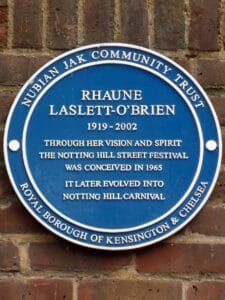
Rhaune Laslett plaque - Moreover, the carnival faces economic challenges. The cost of organising such a large event, from safety measures to waste management, is tremendous. Securing adequate funding is often difficult, and the reliance on volunteers for many tasks underscores the financial strain that the carnival often experiences.
- Environmental impact is another concern. The carnival generates a significant amount of waste, posing a challenge to the local council that has to deal with post-carnival cleanup. Striking a balance between the celebration and environmental responsibility is a continuing struggle.
- Despite these challenges, the Notting Hill Carnival remains a resolute symbol of cultural unity and diversity. Each year, its hardships are met with resilience, as the vibrant celebration of Caribbean culture continues to light up the streets of London with unparalleled fervour.
The Festivities
- The festivities of the Notting Hill Carnival are an explosion of colours, sounds, and emotions, embodying the vibrant spirit of the Caribbean. The streets of Notting Hill come alive, transformed into an open-air theatre where the stories and traditions of Caribbean culture unfold.
- A prominent feature of the carnival is the grand parade, a procession of vibrantly costumed dancers, musicians, and performers. Each costume is a masterpiece, radiant with brilliant colours and intricate details, reflecting the creativity, craftsmanship, and cultural influences of the Caribbean. The parade is led by 'Mas' bands – short for masquerade – that bring the street to life with lively rhythms and captivating performances.
- Music plays a soulful role in the carnival, with the pulsating beats of Soca, Calypso, and reggae reverberating through the streets. Steel pan bands, a stalwart of Trinidadian heritage, add an authentic Caribbean rhythm that is simply irresistible, coaxing even the most reluctant spectators to sway to the music.
- The streets are filled with food stalls, providing a delightful culinary experience that takes you on a journey through the flavours of the Caribbean. Cuisine from various islands, such as jerk chicken from Jamaica, roti from Trinidad, and fried plantains commonly enjoyed across the region, tantalise the taste buds of attendees, introducing them to the flavorful and diverse culinary heritage of the Caribbean.
- The Notting Hill Carnival, held over three days, brings people together in a vibrant celebration of Caribbean culture. It creates an atmosphere filled with joy and a sense of togetherness. It serves as a testament to London's cultural diversity and its acceptance and celebration of different cultures.
Reaction to the Carnival
- British people's response to the Notting Hill Carnival has been a mix of fascination, participation, and at times, apprehension. The carnival, with its roots in Caribbean culture, offers a vibrant and immersive experience that has been embraced by many from the Caucasian community. These individuals are drawn to the carnival’s pulsating rhythms, the vivacious display of costumes, and the opportunity to partake in a grand cultural exchange.
- However, the festival's multicultural nature has also sparked instances of xenophobia, with some individuals expressing discomfort or even fear towards the event. This small fraction has occasionally led to tensions and conflicts, casting a cloud over the joyous celebration.
- Nonetheless, the overwhelming response has been positive, with a large number of Caucasians actively participating in the carnival, whether as attendees, performers, or volunteers. This participation stands as a testament to the carnival's ability to transcend racial boundaries, fostering a sense of unity and shared cultural appreciation.
- Over the years, as understanding and acceptance have grown, the carnival has become an integral part of London's cultural fabric for ‘whites’ and non-’whites’ alike. The Notting Hill Carnival serves as a beacon, demonstrating how cultural diversity can be celebrated, respected, and enjoyed by all, irrespective of race.
Impact
- The Notting Hill Carnival has a significant impact on both individuals and society, leaving a lasting impression on London's cultural scene. On an individual level, the Carnival offers a platform for participants and spectators to celebrate and express their cultural identity. It fosters a sense of belonging and pride in one's ancestry, particularly among the Caribbean diaspora, while also providing an immersive cultural experience for those who are new to Caribbean traditions.
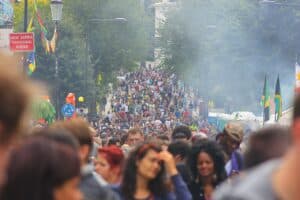
Streets during the Notting Hill Carnival - On a societal level, the Carnival bridges gaps in cultural understanding and promotes diversity and inclusion. It reminds London, a city already known for its multiculturalism, of the richness and vitality of its Caribbean community. The event further stimulates the local economy by drawing in a massive influx of both local and international visitors, boosting tourism and local businesses.
- Moreover, the Carnival has a significant impact on the arts, particularly music and dance. It provides a platform for artists to perform and showcase their talent, contributing to the development and promotion of Caribbean music genres in the UK and beyond.
- In essence, the Notting Hill Carnival, beyond being a vibrant and exuberant celebration, plays a crucial role in cultural preservation, community building, and economic stimulation. It's not just a carnival; it's a unifying symbol that represents the multicultural fabric of Notting Hill and, by extension, London itself.
Image Sources
- https://upload.wikimedia.org/wikipedia/commons/thumb/8/85/Notting_Hill_Carnival_2017_%283%29.jpg/1280px-Notting_Hill_Carnival_2017_%283%29.jpg
- https://upload.wikimedia.org/wikipedia/commons/thumb/8/8d/Rhaune_Laslett-O%27Brien_%28Nubian_Jak%29.jpg/800px-Rhaune_Laslett-O%27Brien_%28Nubian_Jak%29.jpg
- https://upload.wikimedia.org/wikipedia/commons/thumb/7/7d/Notting_Hill_Carnival_%287883238816%29.jpg/1280px-Notting_Hill_Carnival_%287883238816%29.jpg
Frequently Asked Questions
- What is the Notting Hill Carnival?
The Notting Hill Carnival is a yearly street festival and cultural celebration held in the Notting Hill area of London, England. It is one of the largest and most famous carnivals in the world.
- What is the history of the Notting Hill Carnival?
The carnival has its roots in the Afro-Caribbean community of London and was first held in 1966 as a response to racial tensions in the area. It has since evolved into a celebration of Caribbean culture and a symbol of multiculturalism.
- What can I expect to see at the Notting Hill Carnival?
The carnival features colourful and elaborate costumes, vibrant music, dance performances, and a grand parade with bands playing calypso, soca, and steelpan music. There are also numerous food stalls serving Caribbean cuisine.

